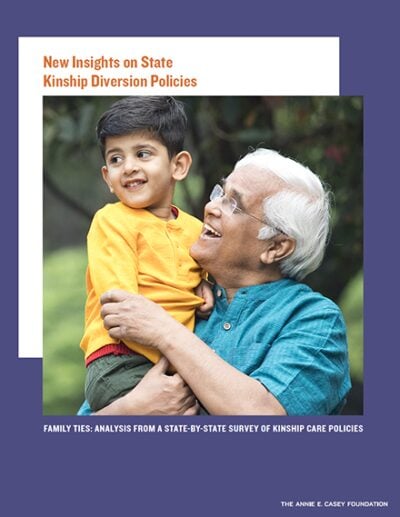Summary
A comprehensive survey of kinship care policies identifies increasing efforts by states, Washington, D.C. and Puerto Rico to promote kinship care and support kinship caregivers of children and youth who are known to the child welfare system. Read the policy data and analysis from the survey, fielded in 2022 for the Annie E. Casey Foundation by Child Trends. This is the third brief in a five-part series that will release throughout 2024.
The Survey
To help build an understanding of the full landscape of kinship policies across states and to identify needed improvements, the Annie E. Casey Foundation asked Child Trends to conduct a survey of state child welfare administrators. The survey, fielded in 2022, updates and expands on the findings of a similarly comprehensive review conducted in 2007. Agencies in the 50 states, the District of Columbia and Puerto Rico received the survey and 46 completed it.
New Insights on State Kinship Diversion Policies
Most child welfare agencies facilitate kinship caregiving arrangements — when relatives step up to raise children when their parents can’t care for them — without moving a child into state custody and formal foster care. The intervention, known as kinship diversion, is a common practice used to keep children out of foster care and connected to a sense of stability, belonging, community and culture. It’s sometimes described as the most common out-of-home placement facilitated by caseworkers and affects an estimated 100,000 to 300,000 children.
During the past 15 years, differing viewpoints have emerged about what role, if any, kinship diversion should play in the child welfare system. In 2013, the Casey Foundation interviewed more than 50 child welfare agency leaders and experts about kinship diversion to better understand the debate.
Some viewed kinship diversion as a positive way to keep families together, reduce the trauma associated with placement in foster care and allow families to make decisions without the oversight of a court or child welfare agency. Others raised concerns, including that some parents and kinship caregivers are coerced or forced into these arrangements without receiving adequate information about the implications of what is happening or their options or rights; that kinship caregivers are not provided sufficient support to care for the children; and that agencies do not provide oversight to ensure the children are safe. More recently, many researchers, advocates and practitioners have argued that in some jurisdictions, agencies’ diversion practices circumvent their legal responsibility to provide for children’s safety and welfare and infringe on the parents’ due process rights without providing access to counsel for parents or any court oversight.
Findings from the Foundation’s 2022 survey advance the field’s understanding of the widely used intervention for which limited data have been publicly available. The brief examines survey data related to state’s policies for creating, overseeing and tracking diversion arrangements and the resources made available for children and kinship caregivers in diversion arrangements. It shows many states that allow kinship diversion continue to lack policies that would help ensure children’s safety, protect parents’ legal rights and provide kinship caregivers with sufficient resources to care for the children entrusted to them.
The survey data also confirms that, because states define and practice kinship diversion differently and because there are no federal reporting requirements on diversion practices, the child welfare field lacks important data to explain how states’ practices can achieve the goal of protecting children, parents and families and providing the support they need to thrive. Almost half of the states that allow kinship diversion reported that they track diversion arrangements. However, few collected data that would enable them to report publicly how many children have been diverted or their outcomes, how many reunify with their parents and how many of these kinship arrangements receive assistance, support or monitoring from the agencies.
As states increasingly rely on relatives and family friends to step up in times of crisis, agencies can examine these findings and work in collaboration with kinship caregivers to strengthen policies, practices and oversight to ensure that decisions are being made with those looking out for the child’s best interests and ensure they receive the support they need to thrive.
Data Tables
The data tables below provide a detailed look into state-by-state responses on kinship diversion policies from the 2022 survey, including comparisons of services offered by child welfare agencies for children or caregivers in licensed, unlicensed or diversion arrangements.






